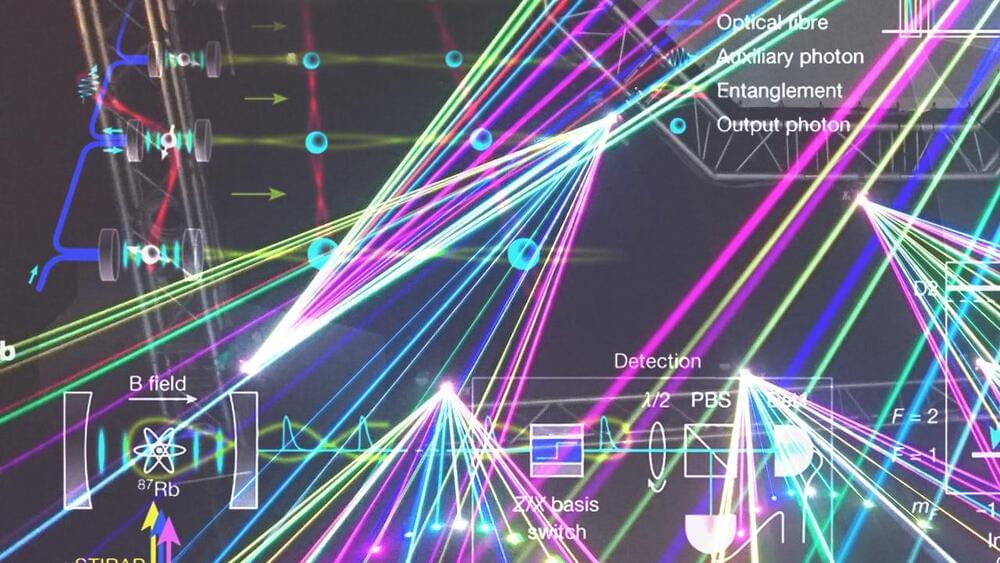German scientists at the Max Planck Institutes have experimentally pushed the limits of quantum technology.




This will be very useful in progressing the field of quantum computers and communication.
Researchers at the Max Planck Institute of Quantum Optics set a new record after achieving a quantum entanglement of 14 photons, the largest on record so far, an institutional press release said.
Quantum entanglement, famously described by Albery Einstein as “spooky action at a distance” is a phenomenon where particles become intertwined in such a way that they cease to exist individually, and changing the specific property of one results in an instant change of its partner, even if it is far away.
Physicists at the Max Planck Institute of Quantum Optics have managed to entangle more than a dozen photons efficiently and in a defined way. They are thus creating a basis for a new type of quantum computer.
In order to effectively use a quantum computer, a larger number of specially prepared – in technical terms: entangled – basic building blocks are needed to carry out computational operations. A team of physicists at the Max Planck Institute of Quantum Optics in Garching has now for the very first time demonstrated this task with photons emitted by a single atom. Following a novel technique, the researchers generated up to 14 entangled photons in an optical resonator, which can be prepared into specific quantum physical states in a targeted and very efficient manner. The new method could facilitate the construction of powerful and robust quantum computers, and serve the secure transmission of data in the future.


Watch a movie backwards and you’ll likely get confused—but a quantum computer wouldn’t. That’s the conclusion of researcher Mile Gu at the Centre for Quantum Technologies (CQT) at the National University of Singapore and Nanyang Technological University and collaborators.
In research published 18 July in Physical Review X, the international team shows that a quantum computer is less in thrall to the arrow of time than a classical computer. In some cases, it’s as if the quantum computer doesn’t need to distinguish between cause and effect at all.
The new work is inspired by an influential discovery made almost 10 years ago by complexity scientists James Crutchfield and John Mahoney at the University of California, Davis. They showed that many statistical data sequences will have a built-in arrow of time. An observer who sees the data played from beginning to end, like the frames of a movie, can model what comes next using only a modest amount of memory about what occurred before. An observer who tries to model the system in reverse has a much harder task—potentially needing to track orders of magnitude more information.


An encryption tool co-created by a University of Cincinnati math professor will soon safeguard the telecommunications, online retail and banking and other digital systems we use every day.
The National Institute of Standards and Technology chose four new encryption tools designed to thwart the next generation of hackers or thieves. One of them, called CRYSTALS-Kyber, is co-created by UC College of Arts and Sciences math professor Jintai Ding.
“It’s not just for today but for tomorrow,” Ding said. “This is information that you don’t want people to know even 30 or 50 years from now.”

As telemedicine has grown more popular, so have devices that allow people to measure their vital signs from home and transmit the results by computer to their doctors. Yet in many cases, obtaining accurate remote readings for people of color has proved a persistent challenge.
Take remote heart rate measurements, for example, which rely on a camera sensing subtle changes in the color of a patient’s face caused by fluctuations in the flow of blood beneath their skin. These devices, part of an emerging class of remote technologies, consistently have trouble reading color changes in people with darker skin tones, said Achuta Kadambi, an assistant professor of electrical and computer engineering at the UCLA Samueli School of Engineering.
Kadambi and his team have now developed a remote diagnostic technique that overcomes this implicit bias against darker skin while also making heart rate readings more accurate for patients across the full range of skin tones. Their secret? Combining the light-based measurements of a camera with radio-based measurements from radar.

An algae-powered computer: Researchers from the University of Cambridge and British tech company Arm have now demonstrated a different source of power for IoT devices: algae.
For their study, published in the journal Energy & Environmental Science, the team built a container about the size of a AA battery out of aluminum and clear plastic. They then filled it with water and algae that use photosynthesis to harvest energy from sunlight.
That process produces a small electric current. An electrode in the device uses that current to power a tiny computer processor commonly used in IoT devices.

The CHIPS Act of 2022 was signed into law on Aug. 9. It provides tens of billions of dollars in public support for revitalization of domestic semiconductor manufacturing, workforce training, and “leap ahead” wireless technology. Because we outsource most of our device fabrication — including the chips that go into the Navy’s submarines and ships, the Army’s jeeps and tanks, military drones and satellites — our industrial base has become weak and shallow. The first order of business for the CHIPS Act is to address a serious deficit in our domestic production capacity.
Notoriously absent from the language of the bill is any mention of chip security. Consequently, the U.S. is about to make the same mistake with microelectronics that we made with digital networks and software applications: Unless and until the government demands in-device security, our competitors will have an easy time of manipulating how chips function and behave. Nowhere is this more dangerous than our national security infrastructure.